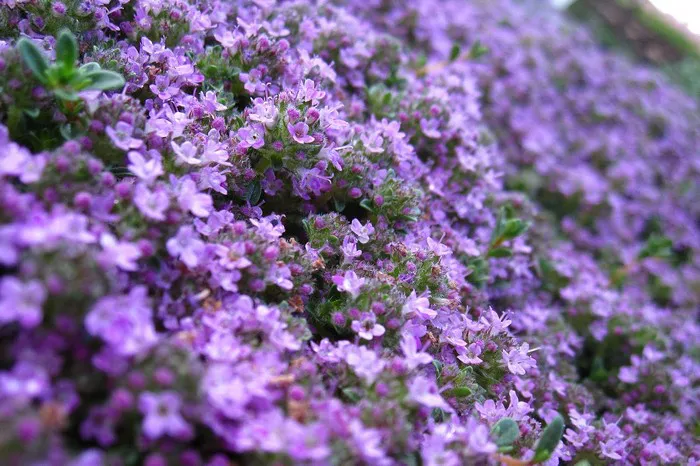Thyme, a popular herb in culinary endeavors, not only enhances the flavor of dishes but also boasts a variety of health benefits. While thyme leaves are commonly used in cooking, its delicate flowers are often overlooked. However, these tiny blossoms pack a punch in terms of flavor and nutrition. In this article, we delve into the edibility, nutritional value, and enticing recipes featuring thyme flowers.
Edibility of Thyme Flowers
Thyme flowers are not only edible but also add a visually appealing touch to dishes. The flowers typically bloom in late spring to early summer, offering a burst of color and flavor to any culinary creation. When harvesting thyme flowers for consumption, it’s essential to ensure they come from organic sources and have not been treated with pesticides or other harmful chemicals.
Thyme flowers have a similar flavor profile to thyme leaves but with a slightly milder taste. They impart a subtle floral note along with the herb’s characteristic earthy, peppery, and lemony undertones. This delicate flavor makes thyme flowers versatile in various dishes, from savory to sweet.
It’s important to note that not all thyme varieties produce flowers suitable for consumption. Varieties such as French thyme (Thymus vulgaris) and lemon thyme (Thymus citriodorus) are commonly used in cooking and yield edible flowers. However, it’s best to research the specific variety of thyme you have before incorporating its flowers into your recipes.
Nutritional Value of Thyme Flowers
Thyme flowers, like the leaves, are packed with essential nutrients and health-promoting compounds. Although they are consumed in smaller quantities compared to the leaves, thyme flowers still contribute to the overall nutritional profile of a dish. Here are some key nutrients found in thyme flowers:
1. Vitamins and Minerals: Thyme flowers contain vitamins A and C, which are important antioxidants that help protect cells from damage caused by free radicals. They also provide small amounts of minerals such as iron, calcium, and manganese, which are essential for various bodily functions.
2. Flavonoids: Thyme flowers contain flavonoids, including apigenin, luteolin, and naringenin, which have antioxidant and anti-inflammatory properties. These compounds may help reduce the risk of chronic diseases such as heart disease and cancer.
3. Essential Oils: Like thyme leaves, thyme flowers contain essential oils such as thymol and carvacrol, which contribute to thyme’s antimicrobial and antifungal properties. These oils not only add flavor to dishes but also have potential health benefits.
While thyme flowers may not provide significant amounts of any one nutrient, their cumulative effect, along with other ingredients in a dish, can contribute to a balanced and nutritious diet.
Recipes Featuring Thyme Flowers
Now that we’ve explored the edibility and nutritional value of thyme flowers, let’s dive into some delightful recipes that showcase their flavor and versatility:
1. Thyme Flower Infused Honey:
Ingredients: Thyme flowers, honey
Instructions: Place a handful of fresh thyme flowers in a clean, dry jar. Pour honey over the flowers until they are completely submerged. Seal the jar and let it sit in a cool, dark place for 1-2 weeks to allow the flavors to infuse. Strain the honey to remove the flowers before using. Drizzle over yogurt, cheese, or toast for a fragrant and flavorful treat.
2. Grilled Peaches with Thyme Flower Syrup:
Ingredients: Peaches, thyme flowers, sugar, lemon juice
Instructions: In a small saucepan, combine thyme flowers, sugar, and lemon juice with a splash of water. Heat over medium heat until the sugar dissolves, then simmer for a few minutes to infuse the flavors. Meanwhile, halve and pit the peaches, then grill them until tender and slightly caramelized. Serve the grilled peaches drizzled with the thyme flower syrup for a delicious dessert or appetizer.
3. Thyme Flower and Goat Cheese Tart:
Ingredients: Puff pastry, goat cheese, thyme flowers, cherry tomatoes, olive oil, salt, pepper
Instructions: Preheat the oven to 400°F (200°C). Roll out the puff pastry and spread a layer of goat cheese over the surface. Sprinkle thyme flowers over the cheese, then arrange halved cherry tomatoes on top. Drizzle with olive oil and season with salt and pepper. Bake for 20-25 minutes or until the pastry is golden brown and the tomatoes are roasted. Garnish with additional thyme flowers before serving.
These recipes are just a few examples of how thyme flowers can elevate the flavor of both sweet and savory dishes. Feel free to experiment with incorporating thyme flowers into your favorite recipes to discover new and exciting flavor combinations.
Conclusion
Thyme flowers are not just a pretty addition to the garden; they also offer culinary enthusiasts a unique and flavorful ingredient to experiment with in the kitchen. From their delicate taste to their nutritional benefits, thyme flowers have much to offer in terms of both flavor and health. Whether infused in honey, drizzled over grilled peaches, or scattered atop a savory tart, thyme flowers add a touch of elegance and sophistication to any dish. So the next time you’re cooking with thyme, don’t forget to consider the blossoms—they might just become your new favorite culinary secret.


